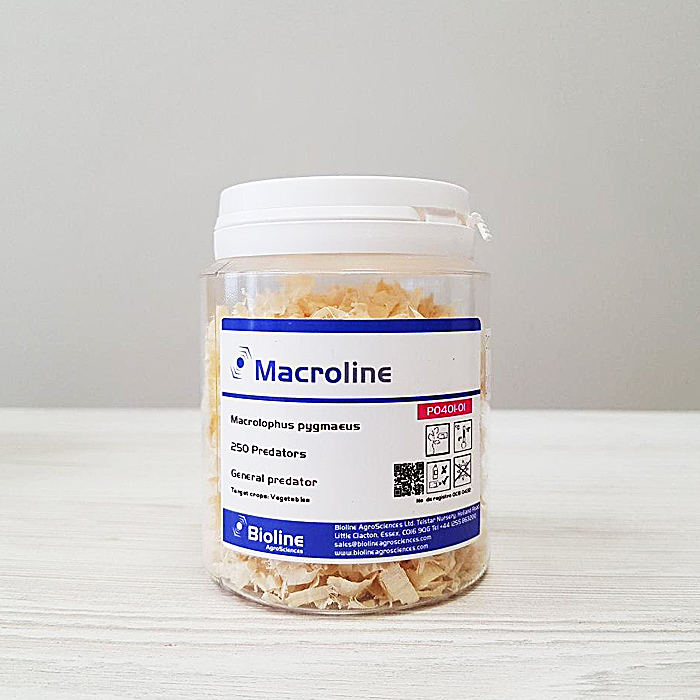Western Flower Thrips (Frankliniella occidentalis);
Greenhouse whiteflies(Trialeurodes vaporariorum);
Tobacco whiteflies (Bemisia tabaci);
Tobacco Thrips (Thrips tabaci);
Cutworm (Helicoverpa spp.);
Aphids (Aphidoidea);
Spider mites (Tetranychidae);
Tomato leafminer (Тutа absoluta).
Tomato, eggplant, sweet pepper, floral crops.
250 ml plastic bottle contains 250/500 predatory bugs
Macrolophus pygmaeus is a small insect (2-11 mm) with elongated body. There are a pair of eyes on the head. Adult Macrolophus species are green and have a dark lateral bar between each of the eyes. The first antennal segment is also dark.
The development cycle has 4 stages: egg – larvae (the first and the second instar) – a nymph (the third, the fourth and the fifth instar) – an imago (female or male). Period of embryonic growth of bug is 14-35 days (on average 21)
The eggs are elongated, slightly curved, and are deeply embedded in the stem or stem of the plant leaves, so they are not visible.
The larvae have no wings; their length is 0.49-0.52 mm, the length of the antennae is 0.3-0.4 mm.
Nymphs have the beginnings of wings. Their body size increases from 1.2 to 3.1 mm with time, the length of the antennae also increases from 0.6 to 1.9 mm. The beginnings of the wings grow from 0.27 to 1.11 mm. with each lining.
Its animal prey comprises a variety of small invertebrates including aphids, whitefly, leaf miners, moth eggs and spider mites, caterpillars. The fourth and fifth instars are the most voracious. One adult kills about 30 young whitefly’s larvae or up to 40 aphids. One individual can eat 3,500 eggs or 2,500 whitefly larvae during all its life.
The nymphs begin hunting at a temperature above 13°C, regardless of the air humidity. The predator population can withstand an increase in temperature up to 42°C, but the hunting period is postponed to cooler hours (evening, night, morning). The rate of nymph development depends on the temperature of the air and lasts from 18 to 25 days. The maximum life span for females is 71 days (30 days on average) and for males 27-30 days (depending on the temperature and kind of food). The potential fecundity of the females is 140 eggs, the actual one is 70-80 eggs and reduces at a temperature above 30°C. One generation development duration is 37-43 days.
| t°C | 10 °С | 15 °С | 20 °С | 25 °С | 30 °С | Crop | Prey |
|---|---|---|---|---|---|---|---|
| The development time (days) | |||||||
| Egg | 36,9 | 18,3 | 11,4 | 10,6 | Тоmato | Whiteflies | |
| Nymphs | 57,8 | 29,4 | 18,9 | 18,7 | Тоmato | ||
| Total | 257 | 94,7 | 47,7 | 30,3 | 29,3 | ||
| Mortality (%) | |||||||
| Nymphs | 41,4 | 13,8 | 15,4 | 11,8 | 46,4 | Тоmato | Whiteflies |
| Egg-laying | |||||||
| Female/eggs | 23 | 151 | 268 | 122 | 87 | Geranium | Pyralidae eggs |
| Life span (days) | |||||||
| Female | 94 | 111 | 85 | 40 | 40 | Geranium | Pyralidae eggs |
| Male | 210 | 123 | 116 | 79 | 53 | ||
| Crop | Prevention | Doses of the application depending on the object complexity and region | ||
|---|---|---|---|---|
| Small | Average | High | ||
| Artificially lightened crop | 3 | 3 | 5 | 10 |
| With out lightning | 2 | 2 | 3 | 5 |
| Frequency of application | 1-2 releases | 3 releases | 4-6 releases | 5-10 releases |

Оставить комментарий